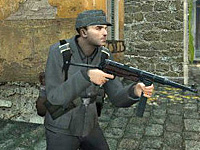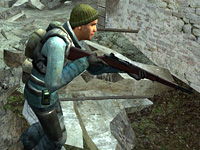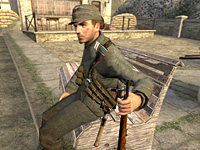The past 3 months have been really stressful due to some changes with my job and the need to actually find some paid work to do. Not a lot has been happening, it’s been a struggle with a lot of sleepless nights and a lot of stress. So on the advice of my doctor, I took a short break and came back to England to visit my family.
A week in, I’ve had a phone call asking me if I’d consider working in Sheffield as a network programmer for a “NextGen” (I hate that phrase) game and asked to peruse a game concept and take part in a conference call with Intel to give my expert opinion. Yeah, Intel….
Why doesn’t this happen when I’m home and available instead of out in the boonies of England in a communications blackhole? Gah!
Related posts
I’ve made another update to my 3DS Max 9 SMD exporter and have decided it’s robust enough to take out of beta and make version one-point-oh.
The changes I made weren’t significant but I did nail one irritating bug where it would crash if the diffuse texture on a mesh wasn’t of a Bitmap type. Once again Autodesk’s recommended 3DXI interface suffers an epic fail in blindly assuming the user has one.
Oh, I also removed the crappy “log to file” feature and replaced it with a proper combined progress/log dialog and compiled a version for the 64-bit edition of 3DS Max 9 as a few people asked for it.
- 3DSMax 9 SMD Export Plug-in version 1.0
Related posts
…or does this tutorial seem a little “wrong”?
Oh lord. It looks like I’ve caused a bit of a stir in the Day of Defeat:Source Modelling forums this past week – custom player models that actually work on-line.
Back in the days of Day of Defeat on the Goldsrc engine, we had a really busy custom player model scene. People were producing models for different countries, armies, regiments, units, etc. There were lots to choose from and customising DoD to your liking was a big thing.
When Valve released Day of Defeat:Source they implemented a file consistency checking system which is designed to prevent people from cheating by using heavily modified models that might give an advantage on-line. This consistency check, in it’s earliest incarnation, pretty much blocked all custom player models and led to a lot of talented character modellers quitting the scene. Why waste all those man hours making a kick ass player model if no-one can ever use it?
A little later, Valve released an addition to the consistency check called pure servers which in theory allowed server admins to permit custom player models or force the player to use the defaults from the GCF file. This is all well and good, but the consistency check is still invoked and your custom model can still fail at that!
Well I love a challenge and seeing people struggle to make even the smallest of edits to the default player models I figured I’d have a go at solving this mystery once and for all.

I’m lucky because I have a reasonably good relationship with some of the guys at Valve so Matt Boone, DoD’s main coder, gave me some of the numbers specifc to DoD and Mike Durand was kind enough to show me the source code for the entire consistency check function. Pure gold when it comes to figuring this stuff out and what exactly is making these models fail.
My test case, which proved successful, was to compile one of the default HL2 NPC characters from the Source SDK to work on-line with DoD:S. It worked, but took a fair bit of hacking and experiementation to not trip the check. From that experiment came a simple “proper” hack – replace the steel helmet on the German assualt class with a M43 field cap – a throw back to the DoD 1.3 days.
After posting a breakdown of how the consistency check works and then a kit of files for correctly compiling custom models so that they pass the check, things have started to take off again. Already people have started re-skinning and improving my cap model, people are starting to suggest other modifications to the player models and a few have actually started re-working and customising new ones.
I really hope this sees a resurgence in the custom player model scene of old and gives DoD:S a healthy shot in the arm.
I posted full details on the consistency check on the Day of Defeat:Source forums, but for those that want to know, heres a brief summary of how the consistency check works:
- Models are CRC checked against those on the server. This is skipped though when pure servers allow custom models.
- Models have their bounds checked against a pre-defined set of ranges. These bounds are calculated when the model is compiled and represent the absolute limit that any part of the models mesh reaches during any animation sequence. These limits can be represented as a bounding box, which is compared against a bounding box defined in game. If any part of your models bounds exceed the game’s, it fails.
- All materials used on the model must be “simple” – i.e. they use only the VertexLitGeneric shader, a diffuse, normal and phong maps. Certain other paramters are allowed but anything else results in the material being rejects and the model failing.
I believe all the current Valve Source based multiplayer games use this check so it may prove useful for CS:S and HL2:DM too.
Related posts
Well I knew I was taking a bit of a risk with my first Vista compatible shell extension and yes, some bugs did creep in. I do test my stuff as thoroughly as I can but sometimes things slip through the net. :o(
Thanks to those who did take the time to contact me and report their bugs. The two most common problems seems to be missing C++ Runtime files (Microsoft requires specific versions for applications compiled with VS2005 SP1) and the extensions crashing when you right-click on a thumbnail.
The runtime issue is solved by installing them as necessary – I’ve provided links to them above the shell extension download page.
The thumbnail crash problem I’ve tracked down and have released an update to the extensions. As normal, you’ll need to uninstall the old version before installing the new but hopefully this will solve it.
For those of you still having problems, especially with Vista, please let me know if you’re getting any wierd error messages or so on. The easiest way to track and solve a bug is if I can get reproduceable proof of the bug and enough info to diagnose it.

